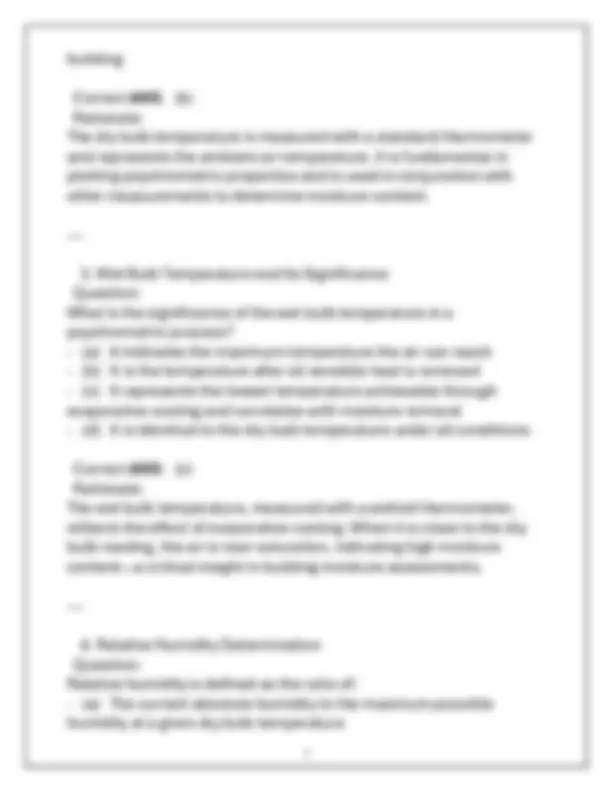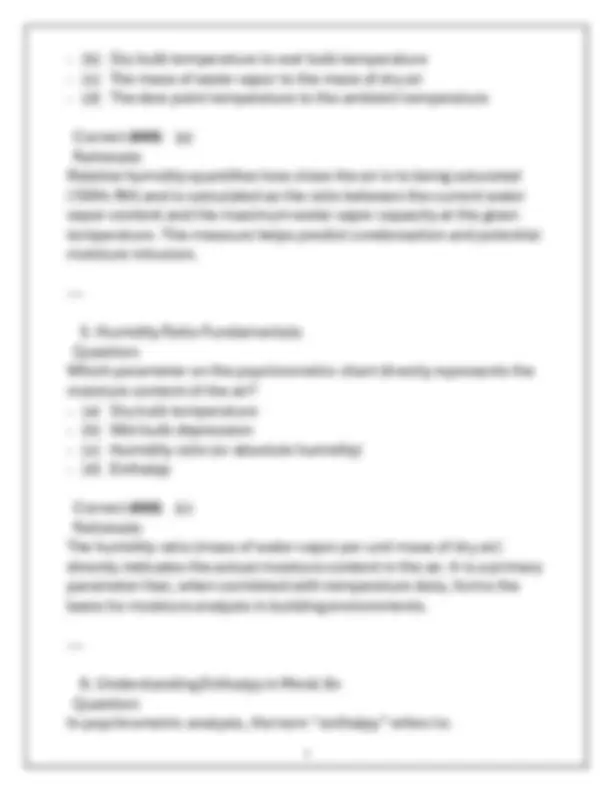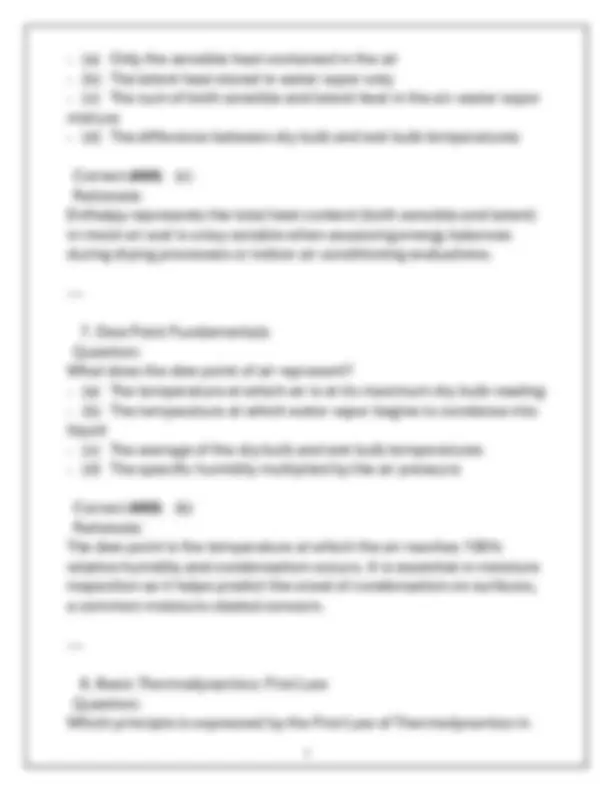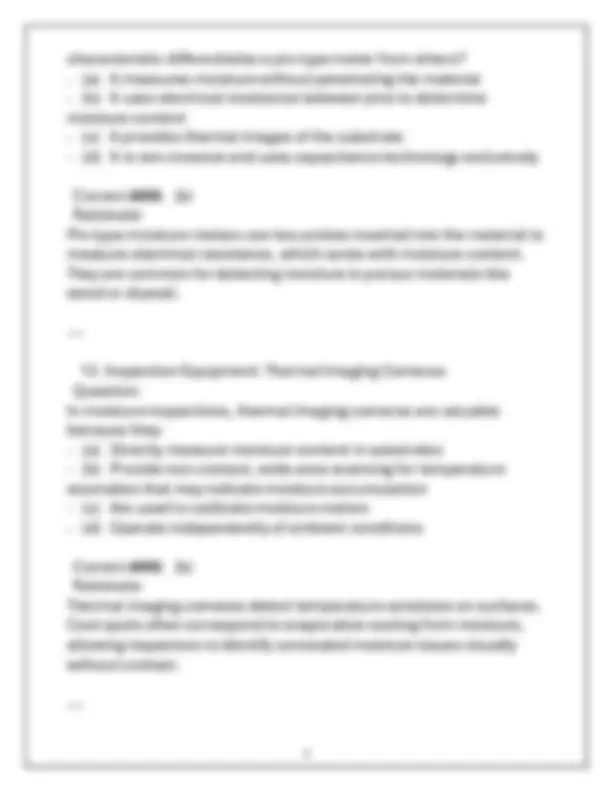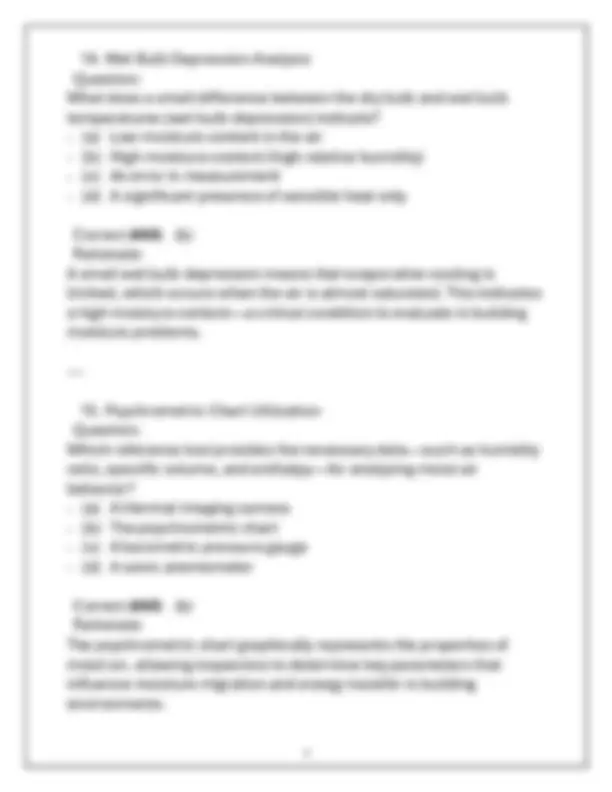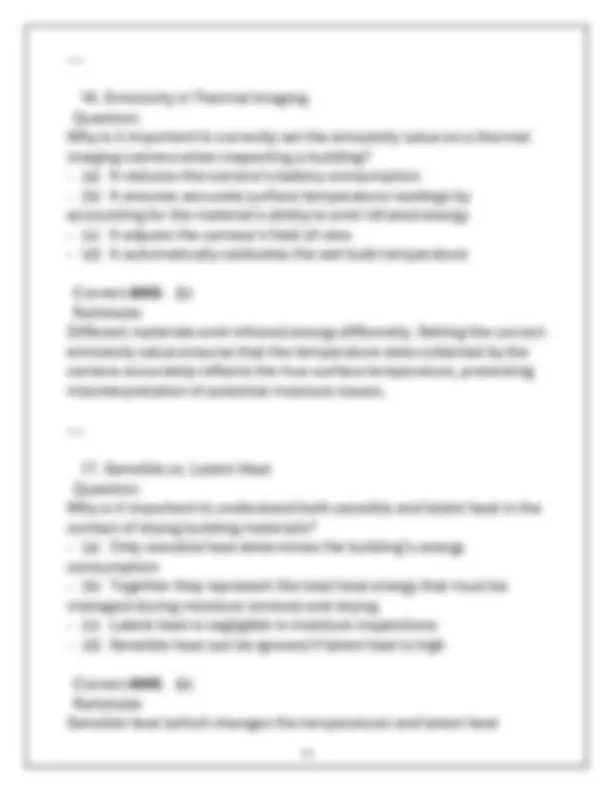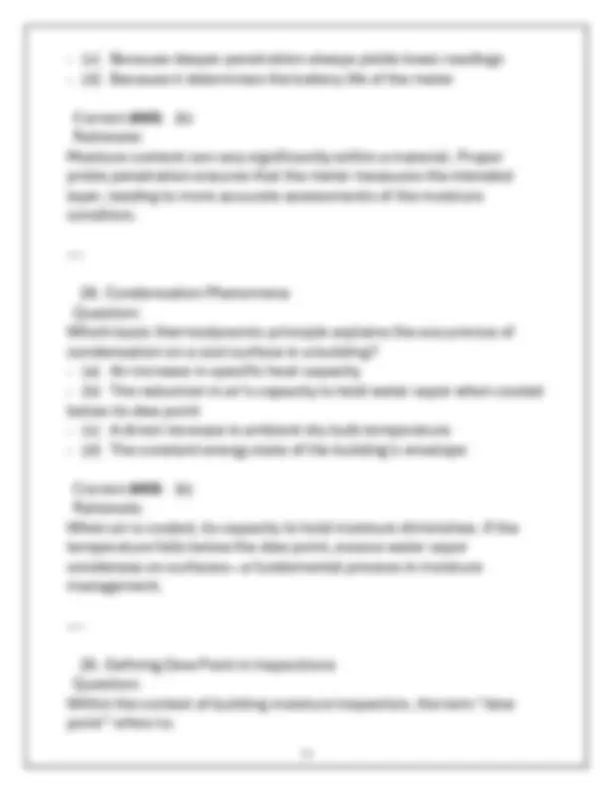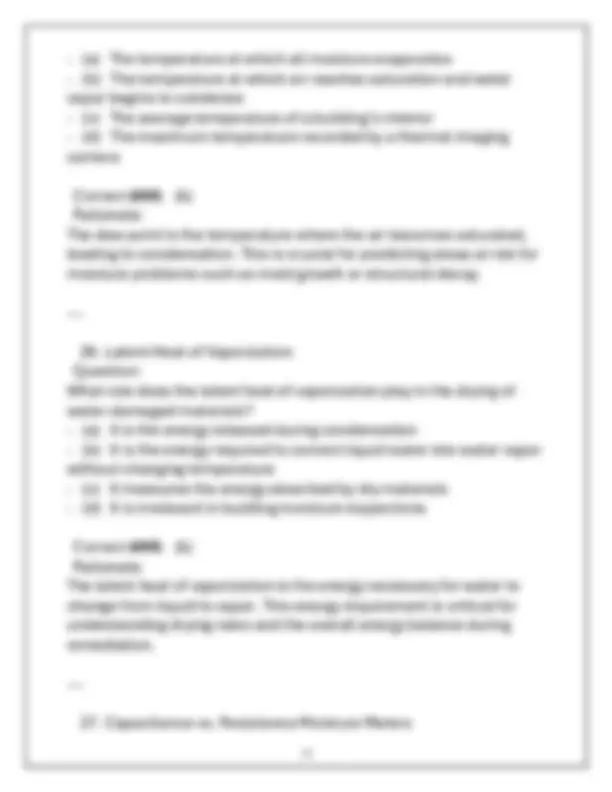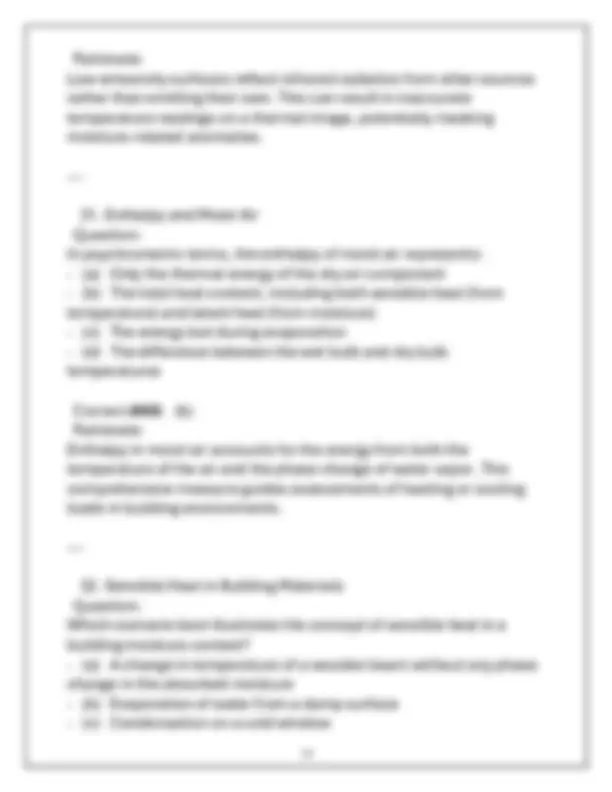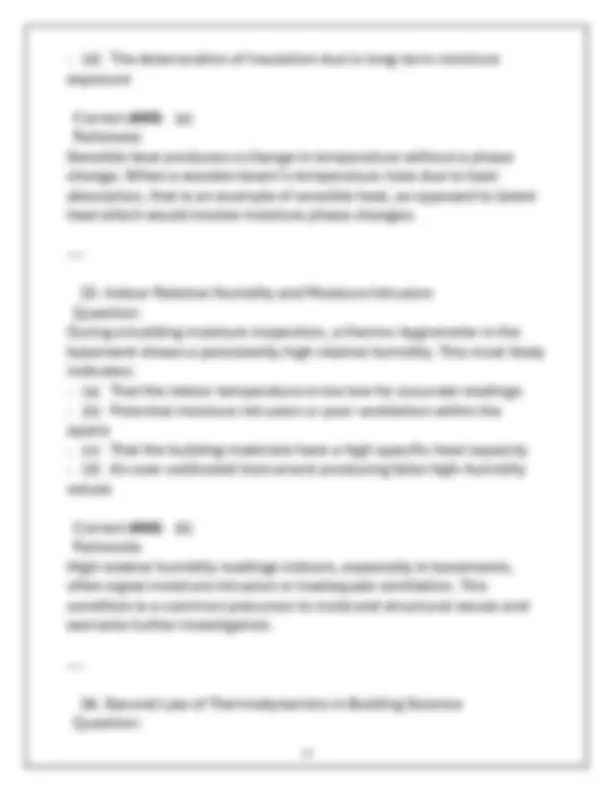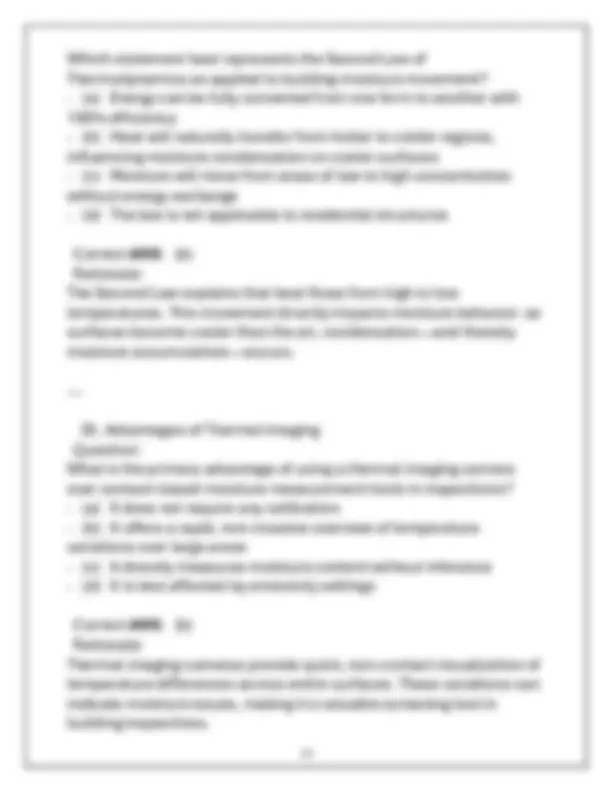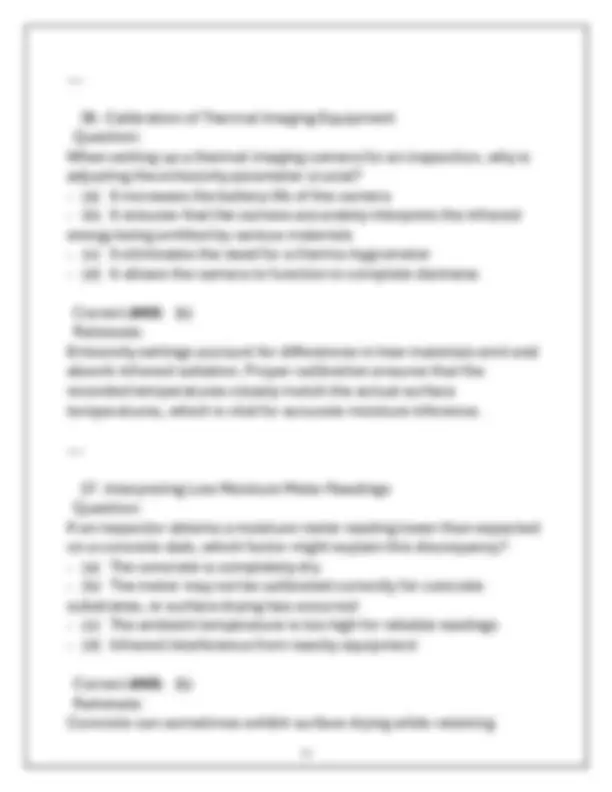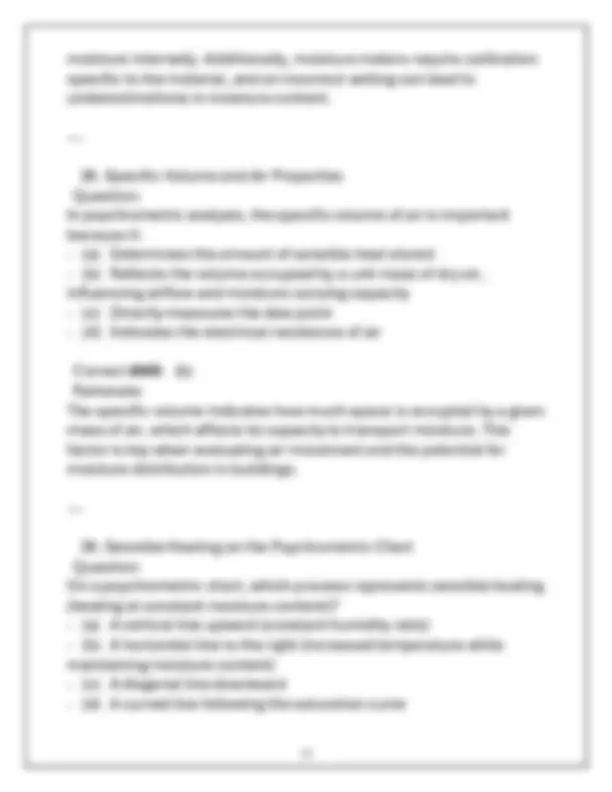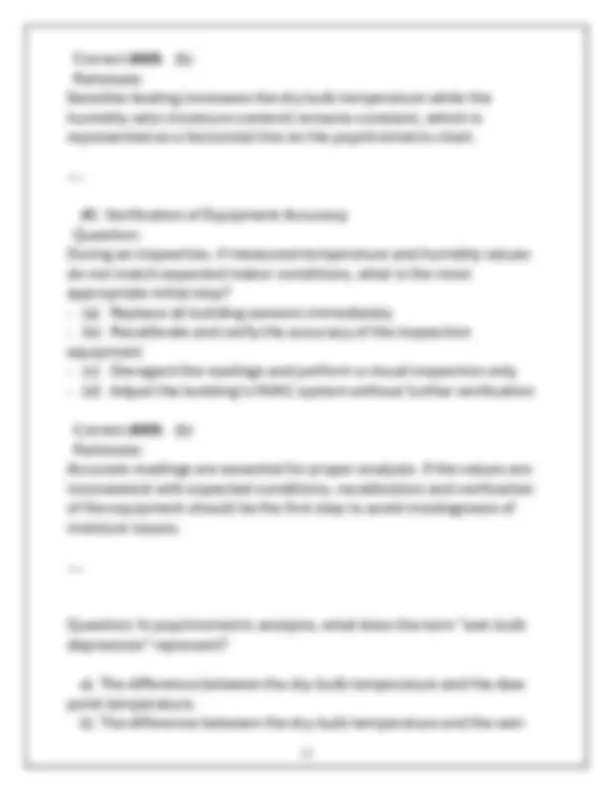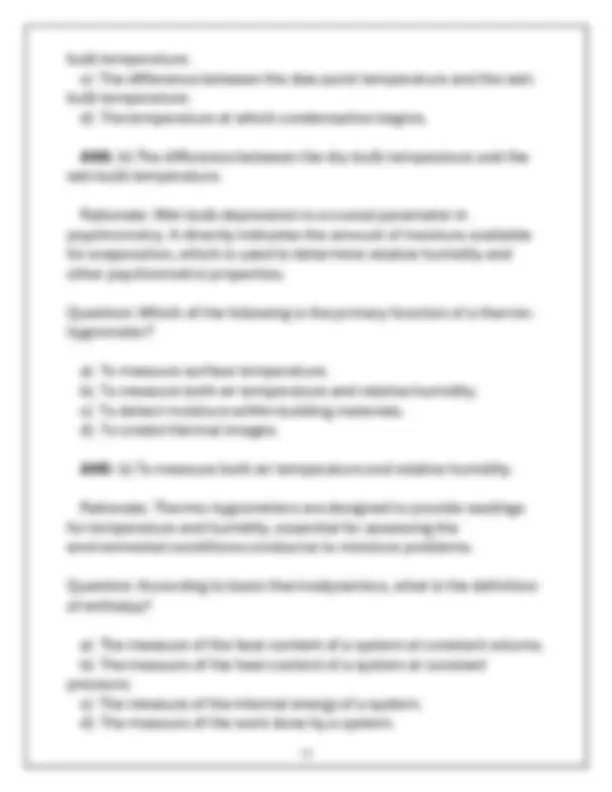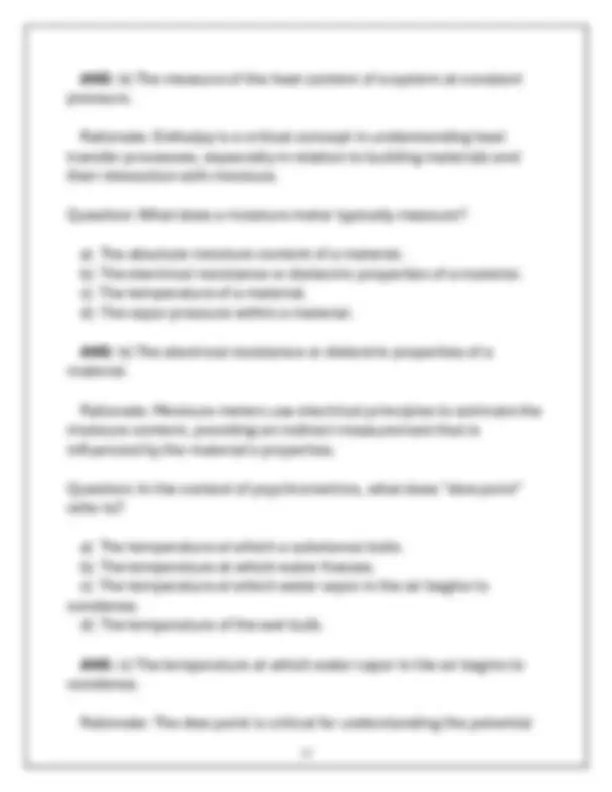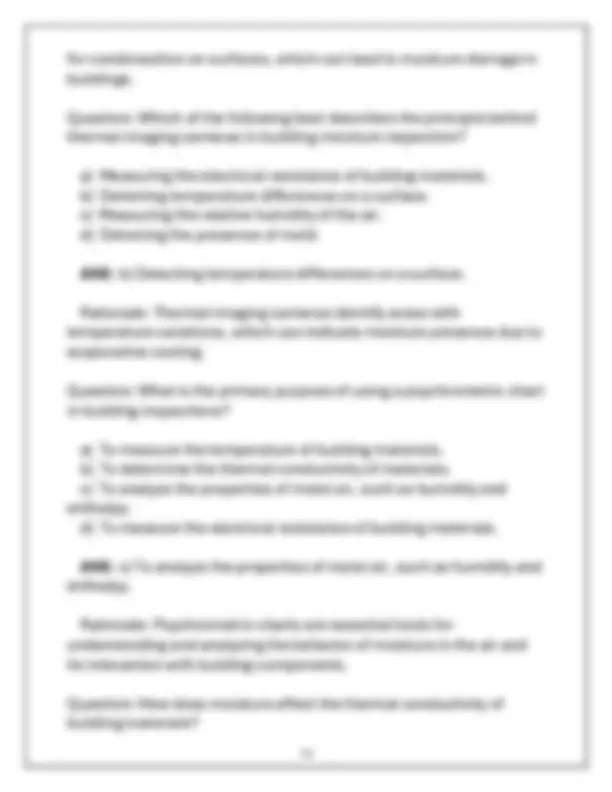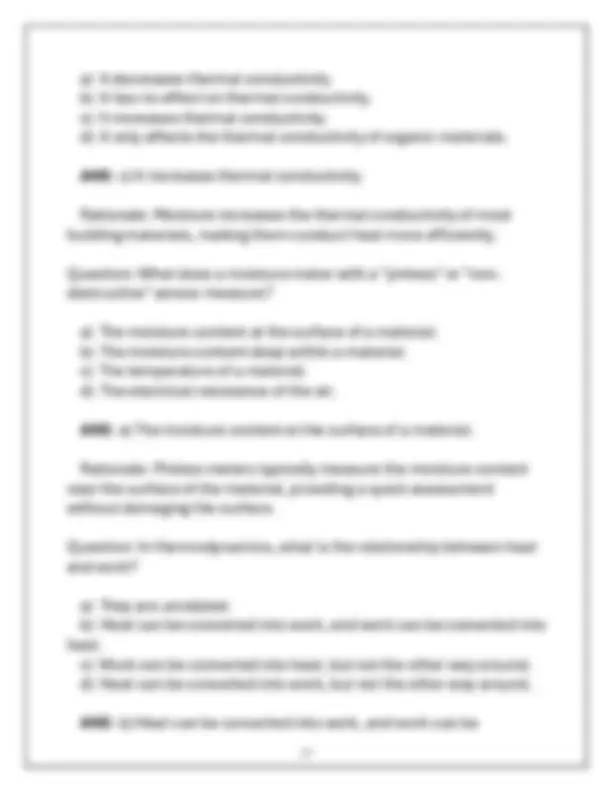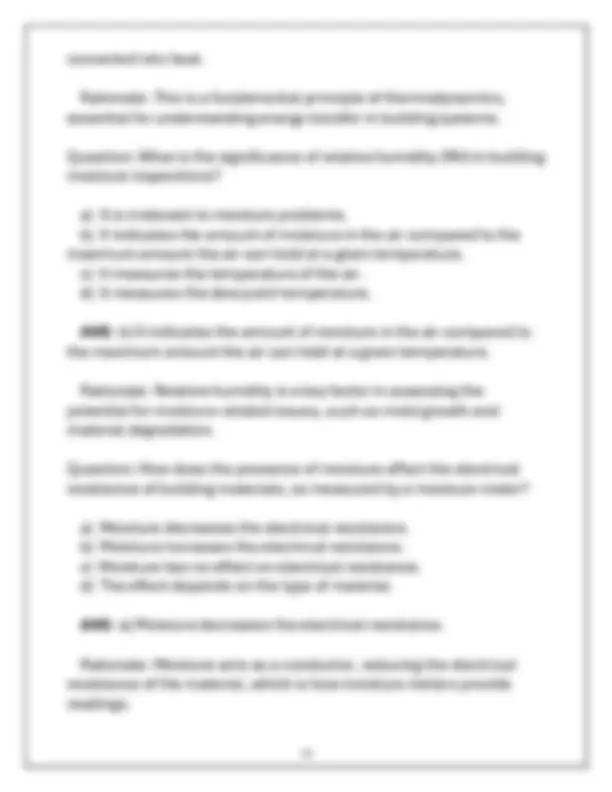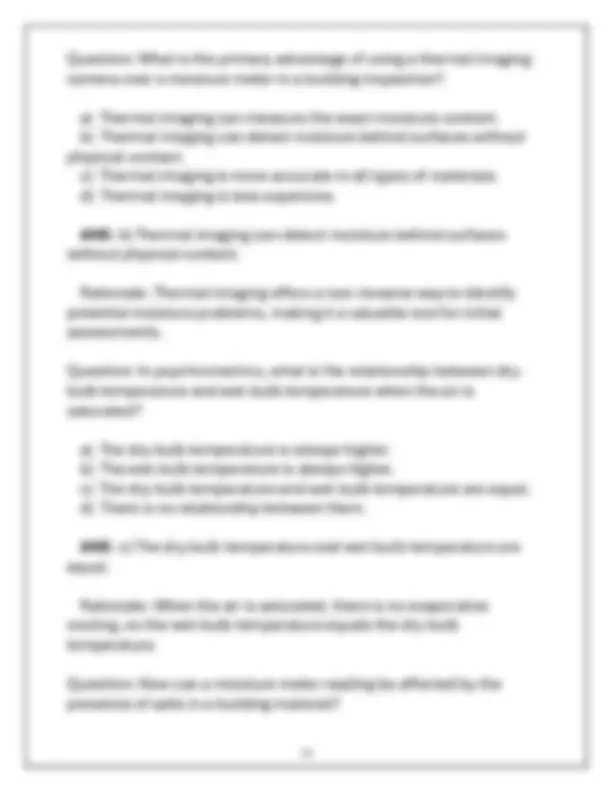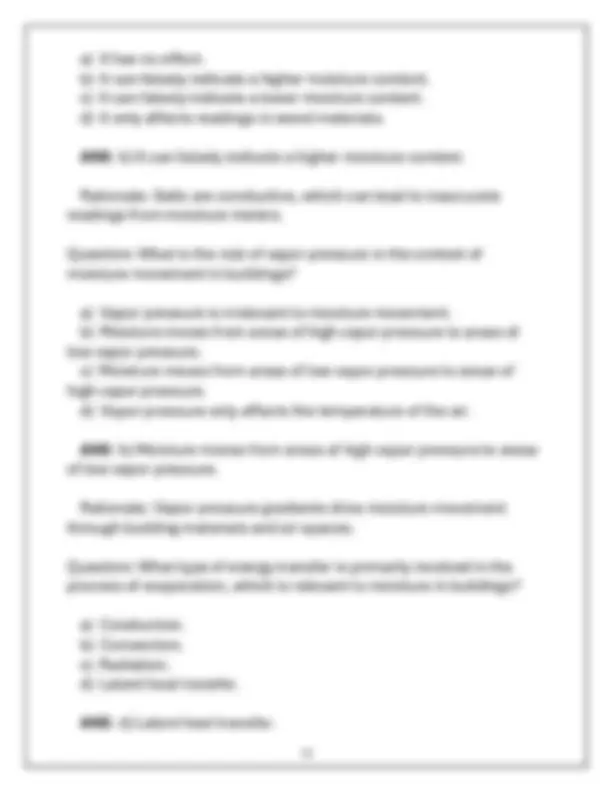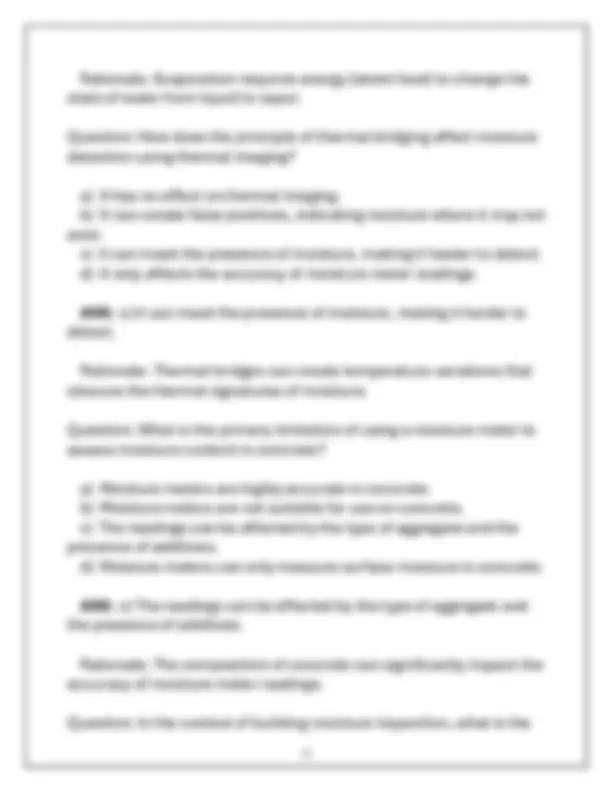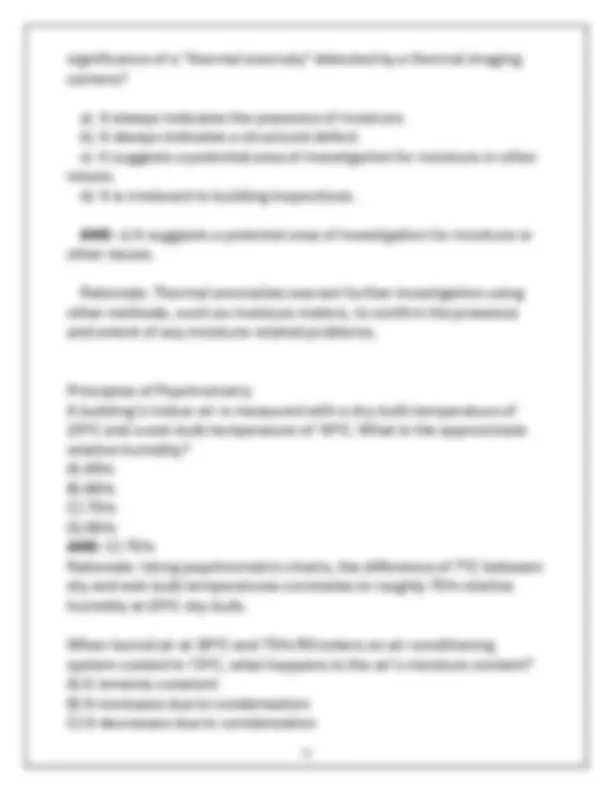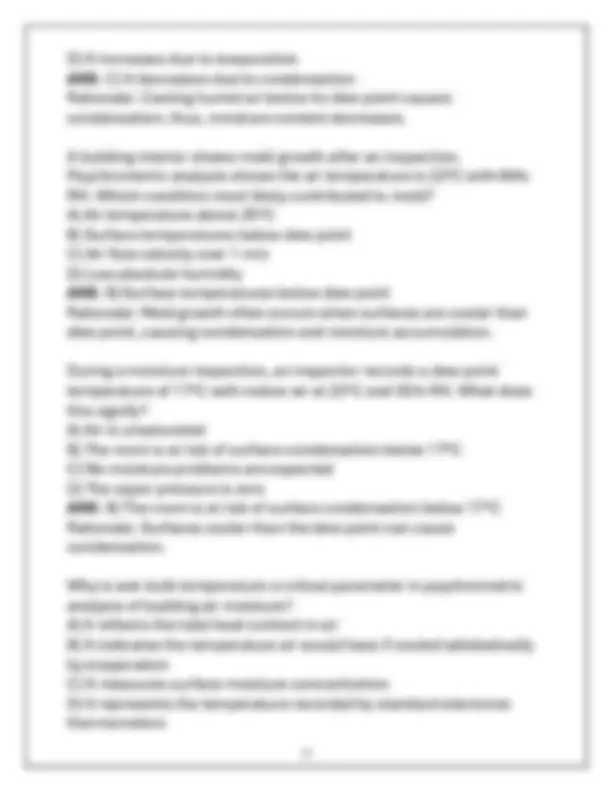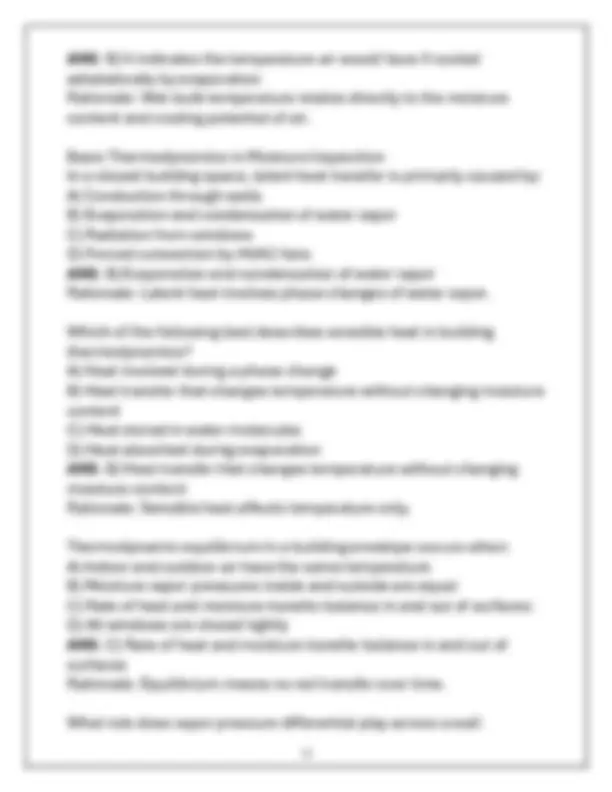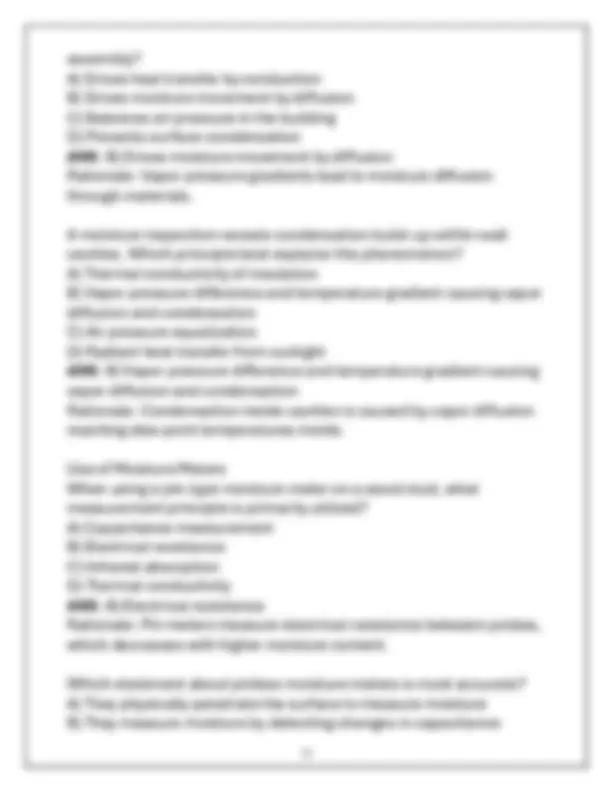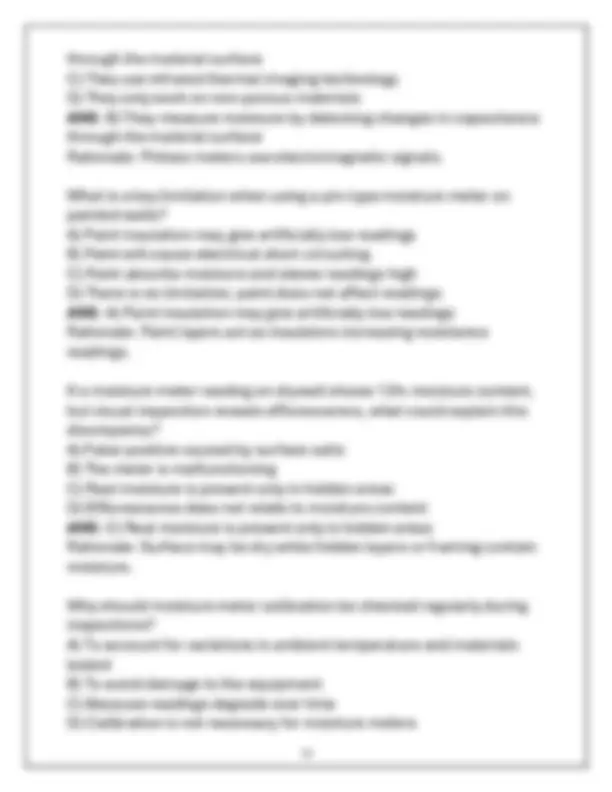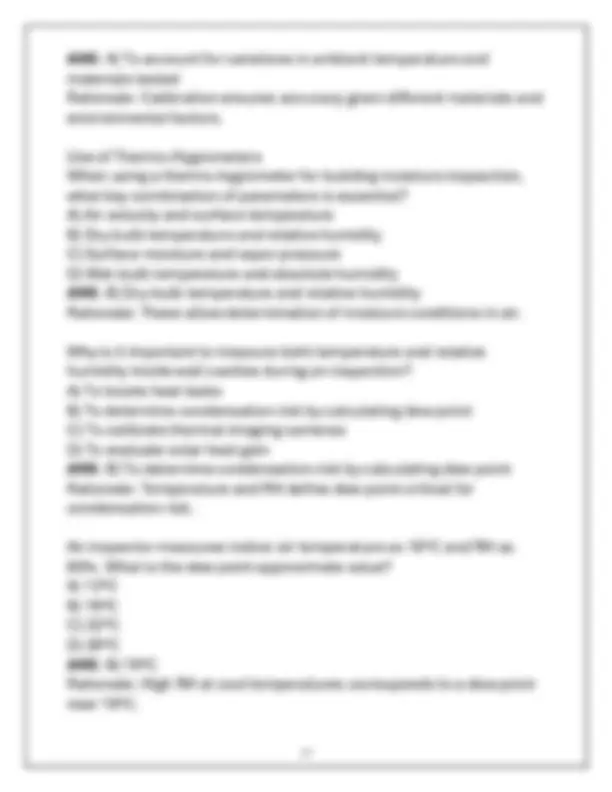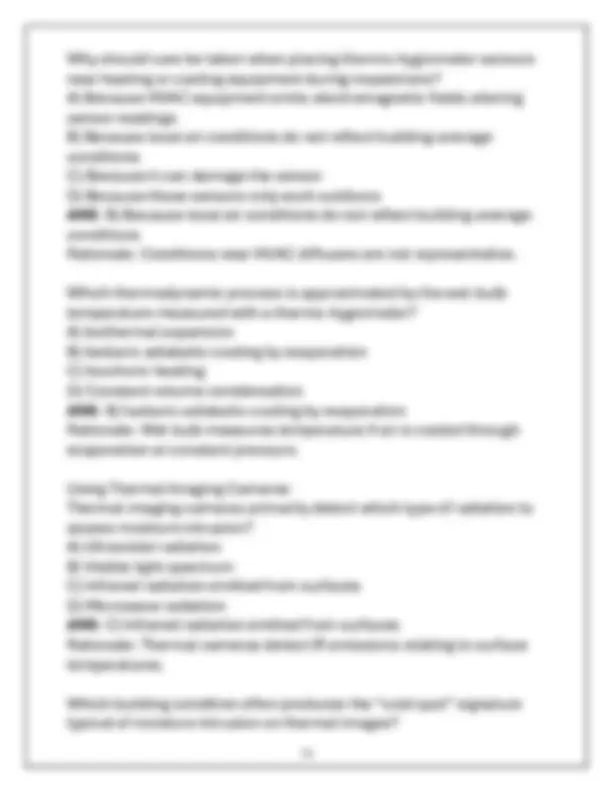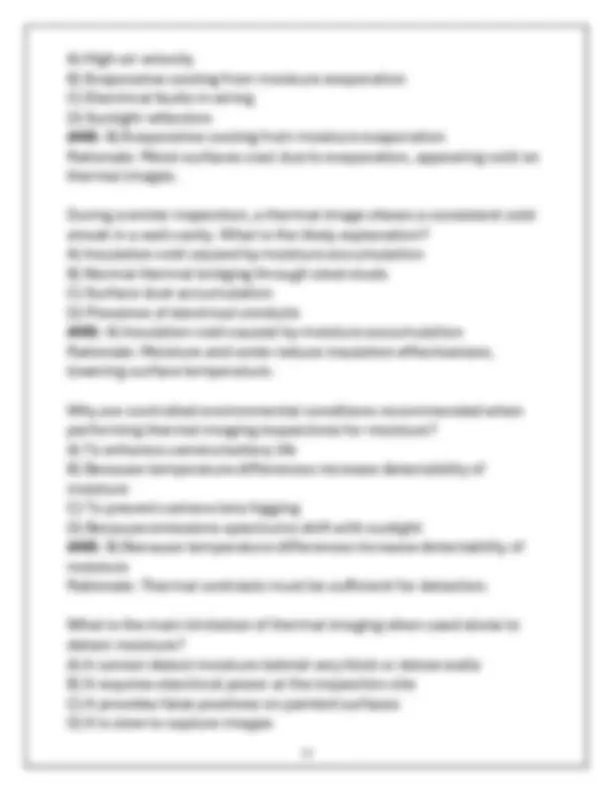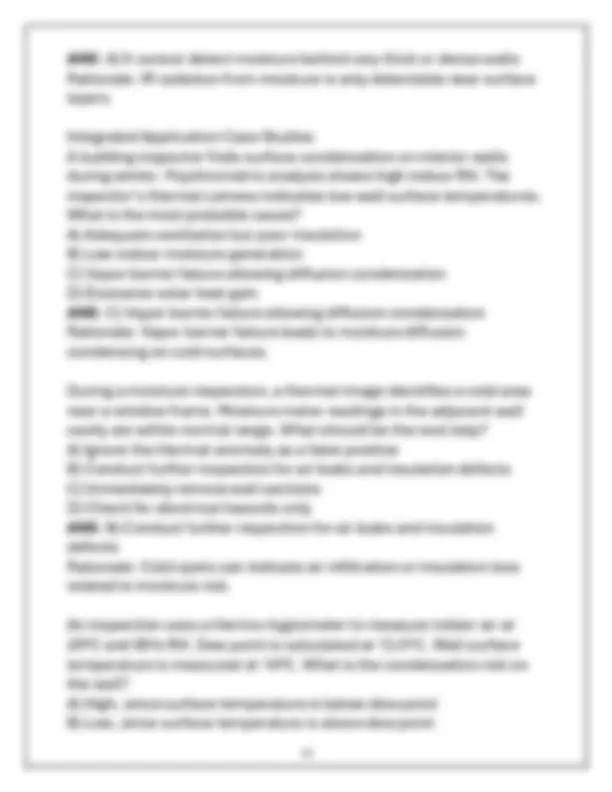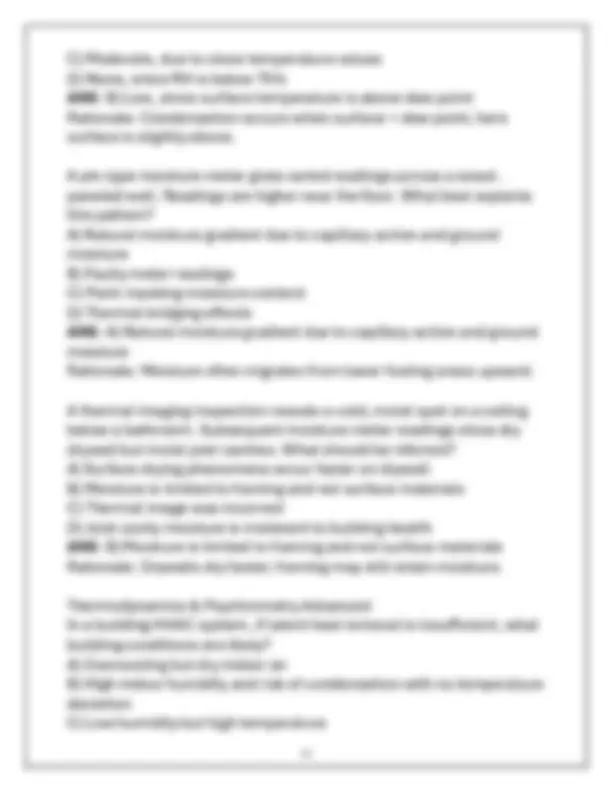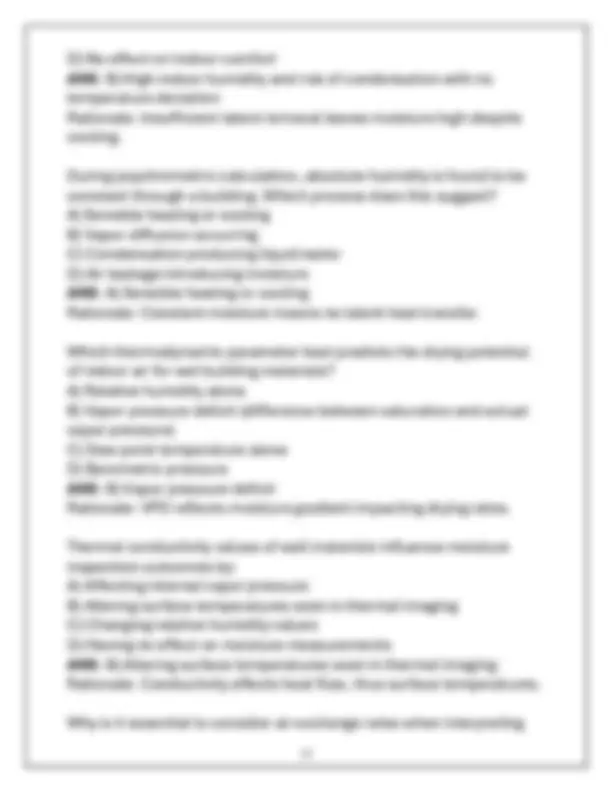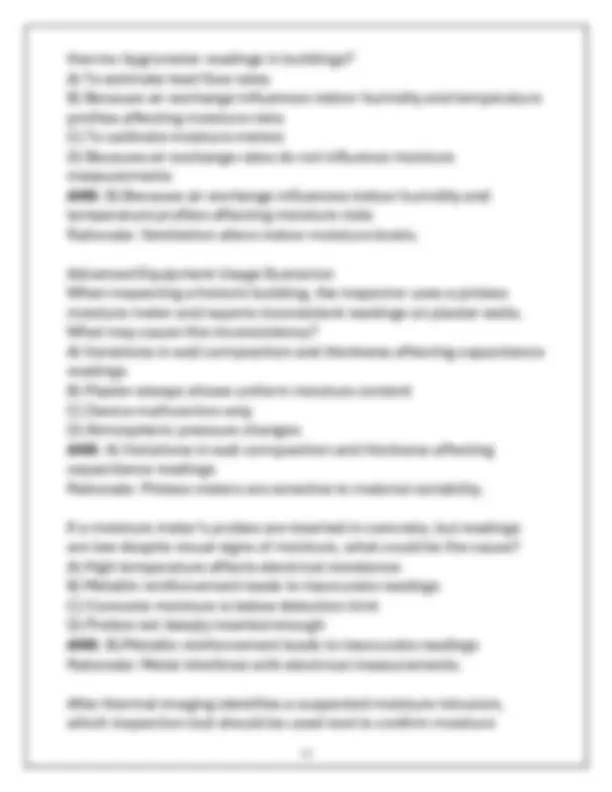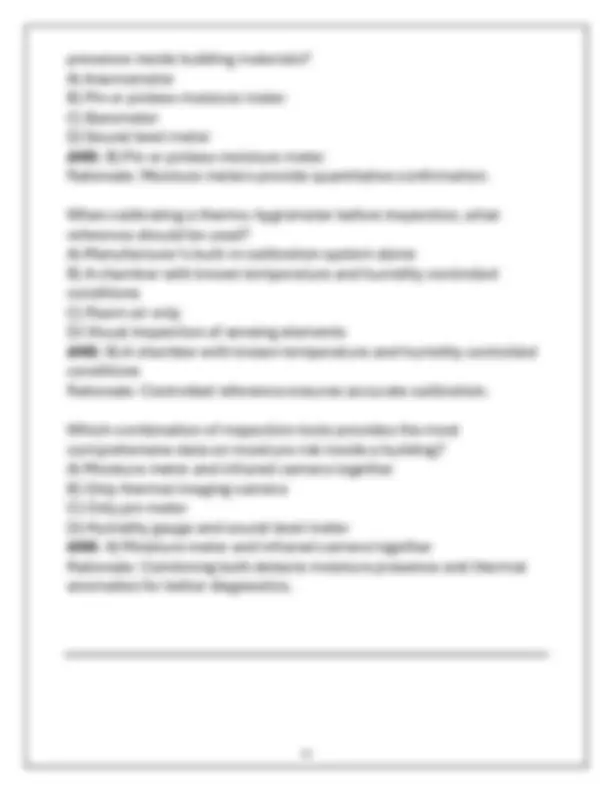Download Building Moisture Inspection: Psychrometry and Thermodynamics Review and more Exams Advanced Education in PDF only on Docsity!
Building Moisture Inspection
Final Assessment Review
(Questions & Solutions)
- Fundamentals of Psychrometry Question: Which definition best describes psychrometry in the context of building moisture inspections?
- (a) The study of thermal insulation and building envelope performance
- (b) The study of the physical and thermodynamic properties of moist air, including water vapor content
- (c) The measurement of only the temperature and pressure of the atmosphere
- (d) The assessment of structural load capacities in moisture-laden environments Correct ANS : (b) Rationale: Psychrometry examines the properties of air–water vapor mixtures. In building moisture inspection, understanding these properties helps evaluate parameters such as humidity ratio, relative humidity, and enthalpy—all critical in assessing moisture conditions.
- Dry Bulb Temperature Measurement Question: What does the dry bulb temperature represent in psychrometric analysis?
- (a) The temperature recorded when the thermometer’s bulb is covered with a wet wick
- (b) The ambient air temperature measured without any evaporative cooling
- (c) The temperature at which water vapor condenses
- (d) The average temperature of multiple measured spots in a
- (b) Dry bulb temperature to wet bulb temperature
- (c) The mass of water vapor to the mass of dry air
- (d) The dew point temperature to the ambient temperature Correct ANS : (a) Rationale: Relative humidity quantifies how close the air is to being saturated (100% RH) and is calculated as the ratio between the current water vapor content and the maximum water vapor capacity at the given temperature. This measure helps predict condensation and potential moisture intrusion.
5. Humidity Ratio Fundamentals Question:
Which parameter on the psychrometric chart directly represents the moisture content of the air?
- (a) Dry bulb temperature
- (b) Wet bulb depression
- (c) Humidity ratio (or absolute humidity)
- (d) Enthalpy Correct ANS : (c) Rationale: The humidity ratio (mass of water vapor per unit mass of dry air) directly indicates the actual moisture content in the air. It is a primary parameter that, when combined with temperature data, forms the basis for moisture analysis in building environments.
6. Understanding Enthalpy in Moist Air Question:
In psychrometric analysis, the term “enthalpy” refers to:
- (a) Only the sensible heat contained in the air
- (b) The latent heat stored in water vapor only
- (c) The sum of both sensible and latent heat in the air–water vapor mixture
- (d) The difference between dry bulb and wet bulb temperatures Correct ANS : (c) Rationale: Enthalpy represents the total heat content (both sensible and latent) in moist air and is a key variable when assessing energy balances during drying processes or indoor air conditioning evaluations.
7. Dew Point Fundamentals Question:
What does the dew point of air represent?
- (a) The temperature at which air is at its maximum dry bulb reading
- (b) The temperature at which water vapor begins to condense into liquid
- (c) The average of the dry bulb and wet bulb temperatures
- (d) The specific humidity multiplied by the air pressure Correct ANS : (b) Rationale: The dew point is the temperature at which the air reaches 100% relative humidity and condensation occurs. It is essential in moisture inspection as it helps predict the onset of condensation on surfaces, a common moisture-related concern.
8. Basic Thermodynamics: First Law Question:
Which principle is expressed by the First Law of Thermodynamics in
- (b) The amount of energy required to change the temperature of 1 unit mass of a substance by 1°C
- (c) The energy lost during heat transfer
- (d) The product of mass and temperature change Correct ANS : (b) Rationale: Specific heat capacity quantifies the energy required to raise the temperature of a unit mass of a substance, providing insight into the thermal responsiveness of building materials, which is critical during drying and remediation processes.
11. Inspection Equipment: Thermo-Hygrometers Question:
What is the primary function of a thermo-hygrometer in building moisture inspections?
- (a) To measure surface moisture content inside materials
- (b) To capture non-contact thermal images of building surfaces
- (c) To measure ambient air temperature and relative humidity
- (d) To determine the dew point through infrared sensing Correct ANS : (c) Rationale: A thermo-hygrometer is used to measure the ambient temperature and relative humidity, which are key inputs for psychrometric calculations and for assessing the potential for condensation and moisture-related issues.
12. Inspection Equipment: Moisture Meters Question:
When selecting a moisture meter for building inspection, which
characteristic differentiates a pin-type meter from others?
- (a) It measures moisture without penetrating the material
- (b) It uses electrical resistance between pins to determine moisture content
- (c) It provides thermal images of the substrate
- (d) It is non-invasive and uses capacitance technology exclusively Correct ANS : (b) Rationale: Pin-type moisture meters use two probes inserted into the material to measure electrical resistance, which varies with moisture content. They are common for detecting moisture in porous materials like wood or drywall.
13. Inspection Equipment: Thermal Imaging Cameras Question:
In moisture inspections, thermal imaging cameras are valuable because they:
- (a) Directly measure moisture content in substrates
- (b) Provide non-contact, wide-area scanning for temperature anomalies that may indicate moisture accumulation
- (c) Are used to calibrate moisture meters
- (d) Operate independently of ambient conditions Correct ANS : (b) Rationale: Thermal imaging cameras detect temperature variations on surfaces. Cool spots often correspond to evaporative cooling from moisture, allowing inspectors to identify concealed moisture issues visually without contact.
- Emissivity in Thermal Imaging Question: Why is it important to correctly set the emissivity value on a thermal imaging camera when inspecting a building?
- (a) It reduces the camera’s battery consumption
- (b) It ensures accurate surface temperature readings by accounting for the material’s ability to emit infrared energy
- (c) It adjusts the camera’s field of view
- (d) It automatically calibrates the wet bulb temperature Correct ANS : (b) Rationale: Different materials emit infrared energy differently. Setting the correct emissivity value ensures that the temperature data collected by the camera accurately reflects the true surface temperature, preventing misinterpretation of potential moisture issues.
- Sensible vs. Latent Heat Question: Why is it important to understand both sensible and latent heat in the context of drying building materials?
- (a) Only sensible heat determines the building’s energy consumption
- (b) Together they represent the total heat energy that must be managed during moisture removal and drying
- (c) Latent heat is negligible in moisture inspections
- (d) Sensible heat can be ignored if latent heat is high Correct ANS : (b) Rationale: Sensible heat (which changes the temperature) and latent heat
(associated with moisture phase changes) collectively define the energy dynamics within a material. Understanding both is essential to accurately model drying processes and prevent condensation.
- Thermal Imaging Interpretation Question: During an inspection, a thermal imaging camera shows a cool area on a wall. What is the most likely explanation?
- (a) The wall is insulated perfectly
- (b) Moisture evaporation is causing evaporative cooling, suggesting possible moisture intrusion
- (c) The ambient temperature is unusually low
- (d) The camera’s battery is low Correct ANS : (b) Rationale: Moisture evaporation from a wall cools its surface, which is detected as a cool spot on a thermal image. This is a common indicator of hidden moisture accumulation that requires further investigation.
- Dew Point Versus Direct Measurement Question: Which of the following parameters is typically not measured directly by a thermo-hygrometer?
- (a) Dry bulb temperature
- (b) Relative humidity
- (c) Dew point (calculated from temperature and humidity)
- (d) Ambient pressure Correct ANS : (c) Rationale:
Correct ANS : (a) Rationale: Ambient conditions such as wind and reflected temperature can alter the perceived surface temperature. These factors must be accounted for—often through calibration—to obtain reliable thermal data.
- Energy Balance in Building Walls Question: According to the First Law of Thermodynamics, which statement best explains heat flow through a wall in steady-state conditions?
- (a) The heat entering the wall is completely stored within the wall
- (b) The heat entering the wall equals the heat leaving it, assuming no net energy storage change
- (c) No heat transfer occurs during steady-state conditions
- (d) The heat leaving the wall is double the heat entering it Correct ANS : (b) Rationale: Under steady-state conditions, the energy entering the wall is balanced by the energy exiting, resulting in no net energy accumulation. This principle is essential in understanding how buildings respond to external temperature differences.
- Probe Penetration and Moisture Distribution Question: When using a pin-type moisture meter, why is probe penetration depth an important factor?
- (a) Because moisture distribution is uniform throughout all materials
- (b) Because local variations in moisture content can lead to misleading readings if the probe does not reach the targeted layer
- (c) Because deeper penetration always yields lower readings
- (d) Because it determines the battery life of the meter Correct ANS : (b) Rationale: Moisture content can vary significantly within a material. Proper probe penetration ensures that the meter measures the intended layer, leading to more accurate assessments of the moisture condition.
24. Condensation Phenomena Question:
Which basic thermodynamic principle explains the occurrence of condensation on a cool surface in a building?
- (a) An increase in specific heat capacity
- (b) The reduction in air’s capacity to hold water vapor when cooled below its dew point
- (c) A direct increase in ambient dry bulb temperature
- (d) The constant energy state of the building’s envelope Correct ANS : (b) Rationale: When air is cooled, its capacity to hold moisture diminishes. If the temperature falls below the dew point, excess water vapor condenses on surfaces—a fundamental process in moisture management.
25. Defining Dew Point in Inspections Question:
Within the context of building moisture inspection, the term “dew point” refers to:
Question: A capacitance moisture meter differs from a resistance (pin-type) meter in that it:
- (a) Requires direct electrical contact with the substrate through pins
- (b) Measures the dielectric properties of a material, allowing for non-intrusive readings
- (c) Can only be used on metal surfaces
- (d) Provides thermal imaging simultaneously Correct ANS : (b) Rationale: Capacitance meters assess the dielectric constant of short sections of a material, offering a non-invasive way to infer moisture content without the need for protruding pins, which is advantageous in certain applications.
28. Sources of Inaccuracy in Moisture Meters Question:
Which condition is most likely to lead to inaccurate readings from a moisture meter?
- (a) Uniform distribution of moisture in the material
- (b) High salt content or heterogeneity within the material altering the electrical conductivity
- (c) A perfectly calibrated probe on a homogeneous surface
- (d) Stable ambient temperature during measurement Correct ANS : (b) Rationale: Heterogeneous materials or the presence of salts can alter electrical conductivity, leading to erroneous readings on moisture meters. Recognizing these limitations ensures proper interpretation of the data.
- Adiabatic Saturation Process Question: The concept of adiabatic saturation is important in psychrometric analysis because it:
- (a) Describes how air’s moisture content remains unchanged during heating
- (b) Models how the properties of air change when water is added without heat exchange, affecting cooling and moisture absorption
- (c) Indicates the maximum temperature achievable in a closed system
- (d) Represents the condition of complete dryness in air Correct ANS : (b) Rationale: Adiabatic saturation describes a process in which water is added to air without external heat exchange. This concept helps predict changes in temperature and humidity in systems experiencing evaporative cooling—a common condition in moisture inspections.
- Effects of Low Emissivity Materials Question: How can low emissivity materials, such as polished metals, affect thermal imaging during building inspections?
- (a) They enhance the accuracy of surface temperature readings
- (b) They may reflect surrounding temperatures, leading to misleading thermal data
- (c) They automatically adjust the camera’s calibration
- (d) They do not affect thermal imaging at all Correct ANS : (b)
- (d) The deterioration of insulation due to long-term moisture exposure Correct ANS : (a) Rationale: Sensible heat produces a change in temperature without a phase change. When a wooden beam’s temperature rises due to heat absorption, that is an example of sensible heat, as opposed to latent heat which would involve moisture phase changes.
33. Indoor Relative Humidity and Moisture Intrusion Question:
During a building moisture inspection, a thermo-hygrometer in the basement shows a persistently high relative humidity. This most likely indicates:
- (a) That the indoor temperature is too low for accurate readings
- (b) Potential moisture intrusion or poor ventilation within the space
- (c) That the building materials have a high specific heat capacity
- (d) An over-calibrated instrument producing false high-humidity values Correct ANS : (b) Rationale: High relative humidity readings indoors, especially in basements, often signal moisture intrusion or inadequate ventilation. This condition is a common precursor to mold and structural issues and warrants further investigation.
34. Second Law of Thermodynamics in Building Science Question:
Which statement best represents the Second Law of Thermodynamics as applied to building moisture movement?
- (a) Energy can be fully converted from one form to another with 100% efficiency
- (b) Heat will naturally transfer from hotter to colder regions, influencing moisture condensation on cooler surfaces
- (c) Moisture will move from areas of low to high concentration without energy exchange
- (d) The law is not applicable to residential structures Correct ANS : (b) Rationale: The Second Law explains that heat flows from high to low temperatures. This movement directly impacts moisture behavior: as surfaces become cooler than the air, condensation—and thereby moisture accumulation—occurs.
35. Advantages of Thermal Imaging Question:
What is the primary advantage of using a thermal imaging camera over contact-based moisture measurement tools in inspections?
- (a) It does not require any calibration
- (b) It offers a rapid, non-invasive overview of temperature variations over large areas
- (c) It directly measures moisture content without inference
- (d) It is less affected by emissivity settings Correct ANS : (b) Rationale: Thermal imaging cameras provide quick, non-contact visualization of temperature differences across entire surfaces. These variations can indicate moisture issues, making it a valuable screening tool in building inspections.

